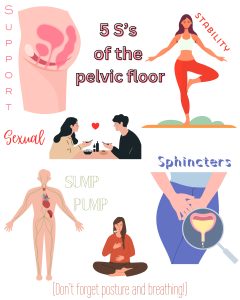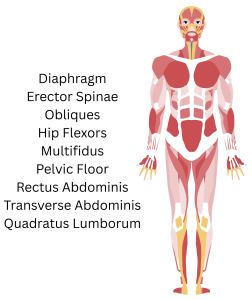6
Function of the Pelvic Floor
 The pelvic floor plays a crucial role in maintaining the proper position and function of the pelvic organs, including the bladder, uterus, and rectum. These muscles provide support by contracting and relaxing in a coordinated manner. When they contract, they create a supportive hammock that helps keep these organs in place, preventing issues such as incontinence or pelvic organ prolapse. This contraction is complemented by the passive support provided by adjacent connective tissues and fascia, which work together to stabilize the pelvic region.
The pelvic floor plays a crucial role in maintaining the proper position and function of the pelvic organs, including the bladder, uterus, and rectum. These muscles provide support by contracting and relaxing in a coordinated manner. When they contract, they create a supportive hammock that helps keep these organs in place, preventing issues such as incontinence or pelvic organ prolapse. This contraction is complemented by the passive support provided by adjacent connective tissues and fascia, which work together to stabilize the pelvic region.
Conversely, when they relax, they allow for functions like urination and bowel movements to occur smoothly. Maintaining the strength and flexibility of the pelvic floor muscles is essential for overall pelvic health and well-being.
Support
The pelvic floor muscles are essential for the structural integrity and support of the abdominal organs, which encompass the bladder, rectum, and uterus in women. These muscles form a robust network that functions like a hammock, cradling these vital organs and protecting them from the detrimental effects of gravity and any excessive downward pressure, such as from heavy lifting or pregnancy.
By maintaining the correct position of these organs, the pelvic floor muscles play a significant role in ensuring their optimal functioning. A well-functioning pelvic floor is vital for various bodily functions, including urination, bowel movements, and during childbirth. Furthermore, these muscles contribute to core stability and have an impact on sexual health. Strengthening and maintaining the health of the pelvic floor can prevent issues like incontinence, pelvic organ prolapse, and enhance overall well-being.
Sphincter
Urination:
The process involves the contraction of the bladder detrusor muscle paired with the relaxation of the urethral sphincter. This reaction is part of an involuntary response controlled by the autonomic nervous system, specifically under the parasympathetic division. At the same time, there is a voluntary relaxation of the pelvic floor muscles, particularly the levator ani muscle.
Bowel movement:
The anal sphincter and puborectalis muscles work in unison to relax, which results in the opening of the rectoanal angle. Simultaneously, the abdominal muscles contract to perform a Valsalva maneuver, increasing abdominal pressure. This relaxation of the anal sphincter is mediated by a reflex of the autonomic nervous system, specifically under the parasympathetic division, allowing for effective regulation of bowel function.
Sexual
The sexual experience is regulated by the pelvic floor muscles, genital structures, and the autonomic nervous system. In females, arousal is characterized by generalized vasocongestion and vaginal lubrication. During the orgasm phase, rhythmic contractions occur in the pelvic floor muscles, anal sphincter, and uterus as a result of a spinal cord reflex. This response is mediated by the autonomic nervous system, specifically through the parasympathetic division during the excitement phase and the sympathetic division during the orgasm phase.
Stability
The pelvic floor is a vital muscle group that forms part of the inner core, alongside the diaphragm, transversus abdominis, and multifidus. This intricate network of muscles spans the bottom of the pelvis and serves several important functions. By supporting the pelvic organs, the pelvic floor aids in maintaining proper posture and provides essential stability to the pelvis and lower back. This stability is crucial for facilitating movement and preventing injuries, as a well-functioning pelvic floor helps to manage intra-abdominal pressure during activities such as lifting, running, and even daily tasks. Strengthening and maintaining the health of the pelvic floor can greatly enhance overall core stability and improve physical performance.
Sump Pump
The pelvic floor acts much like a sump pump, playing a vital role in cardiovascular health by aiding in the return of blood to the heart. This muscular structure, located at the base of the pelvis, comprises a network of muscles and connective tissues that support various organs, including the bladder, intestines, and uterus in females. As these muscles contract and relax during activities such as breathing or movement, they create pressure changes in the abdominal cavity that assist in the venous return of blood. This process is essential for maintaining effective circulation, preventing blood pooling, and ensuring that the heart receives a consistent supply of oxygenated blood necessary for overall bodily function.
Bonus- posture and breathing!
The pelvic floor is a complex structure of muscles, ligaments, and tissues that forms a supportive hammock at the base of the pelvis. It serves crucial functions beyond just supporting pelvic organs such as the bladder, intestines, and uterus. One of its key roles is to maintain proper posture by stabilizing the pelvis and lower spine, aiding in alignment and balance throughout the body.
Moreover, the pelvic floor is integral to effective breathing mechanics. It works in conjunction with the diaphragm, the primary muscle responsible for inhalation, to create a coordinated breathing pattern. As the diaphragm descends during inhalation, the pelvic floor muscles can relax slightly, allowing for a greater expansion of the thoracic cavity. Conversely, during exhalation, the pelvic floor can engage to assist in the expulsion of air. These videos (video 1, video 2) demonstrate how the pelvic floor is interconnected with posture and respiration. This synergy is essential for overall physical health and well-being.
Core Muscles:

The core muscles serve as a vital pillar that connects the upper and lower body, forming the foundation of our physical stability. A resilient core is essential for navigating daily life, as nearly every movement we make originates from the torso. The abdominal and back muscles work in unison, providing continuous support to the spine whether we are sitting, standing, bending forward, or lifting objects from the floor.
In addition, the core muscles work closely with the pelvic floor, creating a synergistic relationship that enhances our overall stability and mobility. This collaboration not only supports proper posture and alignment but also plays a crucial role in activities that involve bending, twisting, and heavy lifting. A strong pelvic floor helps maintain intra-abdominal pressure, which is necessary for safe and efficient movement during physical exertion. Together, the core and pelvic floor provide a robust support system, ensuring that our bodies remain balanced and resilient throughout various activities.
Explore
Resources:
Crumbie, L. (2023, August 15). Muscles of the pelvic floor. Kenhub. https://www.kenhub.com/en/library/anatomy/muscles-of-the-pelvic-floor
Female pelvic floor. (2017). ElSevier. (2nd ed.), 1050-1077. https://doi.org/10.1016/B978-0-323-47781-9.50046-5
Loyola University Medical Education. (1996). Muscles of the pelvis and perineum. https://www.meddean.luc.edu/lumen/meded/grossanatomy/dissector/mml/pelvis.htm
Physiopedia. (2020, October 17). Pelvic floor anatomy. https://www.physio-pedia.com/Pelvic_Floor_Anatomy
Victorian State Government. (2015, June 30). Abdominal muslces. Better Health Channel. https://www.betterhealth.vic.gov.au/health/conditionsandtreatments/abdominal-muscles
Media Attributions
- 5 S’s
- Add a little bit of body text
